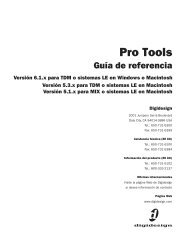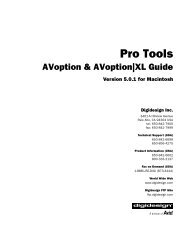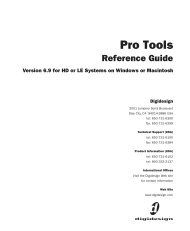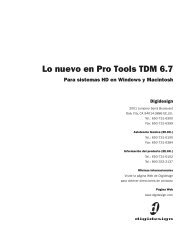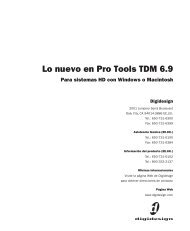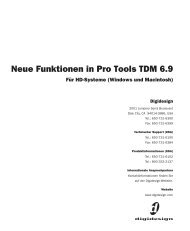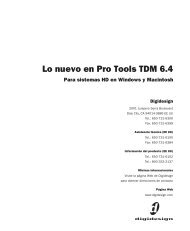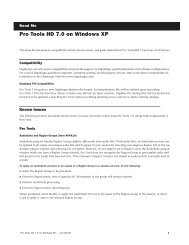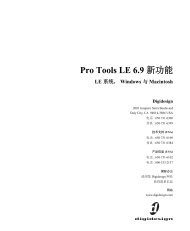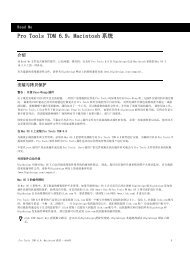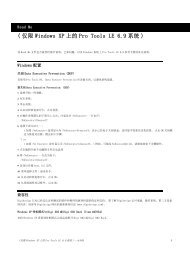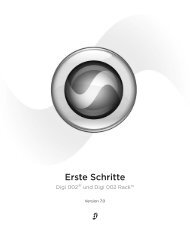5.1 DigiRack Plug-Ins Guide - Digidesign Support Archives
5.1 DigiRack Plug-Ins Guide - Digidesign Support Archives
5.1 DigiRack Plug-Ins Guide - Digidesign Support Archives
Create successful ePaper yourself
Turn your PDF publications into a flip-book with our unique Google optimized e-Paper software.
50<br />
Crossfade length affects the amount of<br />
“smoothing” performed on audio material to<br />
prevent audio artifacts such as clicks. In general,<br />
small narrow-range time (length) changes require<br />
longer crossfades while larger changes in<br />
length require smaller crossfades. The disadvantage<br />
to long crossfade times is that they smooth<br />
the signal, including any transients. While this<br />
can be desirable for audio material such as vocals,<br />
it is not appropriate for material with sharp<br />
transients such as drums or percussion.<br />
The default setting for this parameter is Auto<br />
(full left), in which crossfade times are set automatically,<br />
according to the percentage of<br />
change in length for the current process. This<br />
setting should be sufficient for most applications.<br />
However, by using this slider, you can<br />
manually adjust and optimize crossfade times if<br />
necessary. For audio material with sharper attack<br />
transients, use smaller crossfade times. For<br />
audio material with softer attack transients, use<br />
longer crossfade times.<br />
Min Pitch Sets the minimum, or lowest, pitch<br />
that will be used in the plug-in’s calculations<br />
during the Time Compression/Expansion process.<br />
The control has a range of 40 Hz to 1000<br />
Hz.<br />
This slider should be set lower when processing<br />
bass guitar or other instruments with a similarly<br />
low frequency range. Set this parameter higher<br />
when processing higher frequency range sounds<br />
or instruments.<br />
Accuracy Prioritizes the processing resources allocated<br />
to audio quality (Sound) or timing<br />
(Rhythm). Moving the slider towards “Sound”<br />
generally results in better sonic quality and<br />
fewer audio artifacts. Moving the slider towards<br />
“Rhythm” puts the emphasis on keeping the<br />
tempo consistent.<br />
<strong>DigiRack</strong> <strong>Plug</strong>-<strong>Ins</strong> <strong>Guide</strong><br />
When you are working with audio loops, listen<br />
carefully and adjust the Accuracy slider until<br />
you find a setting that keeps timing solid within<br />
the region. If you don’t, start and end times may<br />
be precise, but the beats in rhythmic material<br />
may appear to be shuffled if too little priority is<br />
given to Rhythm.<br />
Time Compression & Expansion settings<br />
created in version 4.x and later of Pro Tools<br />
for Windows are not compatible with later<br />
versions. importing a 4.x session into version<br />
5.x and later will cause settings to be<br />
lost.<br />
Pitch Shift<br />
The Pitch Shift plug-in allows you to adjust the<br />
pitch of any source audio file with or without a<br />
change in its duration. This is a very powerful<br />
function which essentially allows sounds to be<br />
transposed a full octave up or down in pitch<br />
with or without altering playback speed.<br />
Pitch Shift plug-in



